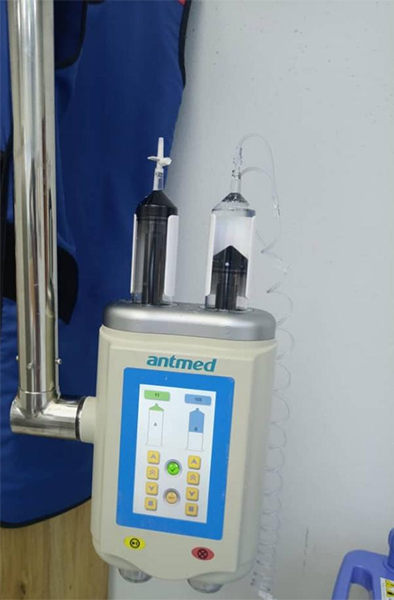Computed tomography (CT) scan is a useful diagnostic tool for detecting diseases and injuries. It uses a series of X-rays and a computer to produce a 3D image of soft tissues and bones. CT is a painless, noninvasive way for your healthcare provider to diagnose conditions. You may have a CT scan at a hospital or imaging center.
Medical professionals use computed tomography, also known as CT scan, to examine structures inside your body. A CT scan uses X-rays and computers to produce images of a cross-section of your body. It takes pictures that show very thin “slices” of your bones, muscles, organs and blood vessels so that healthcare providers can see your body in great detail.
Patient Entering CT Scanner.
What is a CT contrast Media Injector?
Contrast injectors are medical devices that are employed for injecting contrast media into the body to enhance the visibility of tissues for medical imaging procedures. Through technological advancements, these medical devices have evolved from simple manual injectors to automated systems that not only precisely control the amount of the contrast media agent used, but also facilitate automated data collection and personalized doses for each individual patient. These devices can control contrast dosage, record the amount used, speed injections to keep up with faster computed tomography (CT) scanners, and warn clinicians of potential hazards, such as air embolisms or extravasations. There are some key differences buyers should be aware of between injector systems used for angiography, CT and magnetic resonance imaging (MRI).
Antmed has developed specific contrast injectors for intravenous procedures in Computed Tomography (CT) and Magnetic Resonance Imaging (MRI) and for intrarterial procedures in cardiac and peripheral intervention.
Characteristics of Antmed CT Power Injectors
Flow Rate
- It is adjusted in steps of 0.1 ml. from 0.1 -10mls. If the flow rate is too high for the vein being used it can cause an increase in pressure leading to venous rupture and resultant extravasation into the subcutaneous tissues.
Delivery Pressure
325PSI to reduce the risk of extravasation: it is essential to be able to programme a maximum pressure limit which may vary depending on size of the vein and flow rate of the injection. Once this pressure limit is reached, flow rate is reduced and a warning flashes on the screen. The operator has the option to pause the injection to check if extravasation has not occurred.
Volume Ranges
- Different volumes of contrast saline will be required dependant on the area being scanned, scan protocol and patient considerations such as weight of the patient and kidney function. All the above injectors have a maximum syringe size of 200 mls for both contrast and saline sides.
Syringe Warmer
- To reduce viscosity, the contrast is pre-warmed to near body temperature which reduces adverse effects. Once the syringe is positioned on the injector, it is kept at this temperature until required.
Simultaneous Injection
Simultaneous Injection delivers dual injection protocols of contrast media and saline simultaneously.
Configuration
- injectors are available as either ceiling- or pedestal-mounted.
Syringes & Tubing
The syringe and tubing packs of 200 mL/ 200 mL are available in various packs to meet your requirements for single/ dual injection protocols.
Note: The syringe packs are compatible with antmed Injectors.
You can find more details from below link about our CT contrast media injector:
https://www.antmedhk.com/antmed-imastar-ct-dual-head-contrast-media-injection-system-product/
For operational video, please click here:
https://www.youtube.com/channel/UCQcK-jHy4yWISMzEID_zx4w/videos
We have sold power injectors to over 3,000 units worldwide and to more than 70 countries. If you are interested, please contact us at info@antmed.com.
Post time: Nov-14-2022




